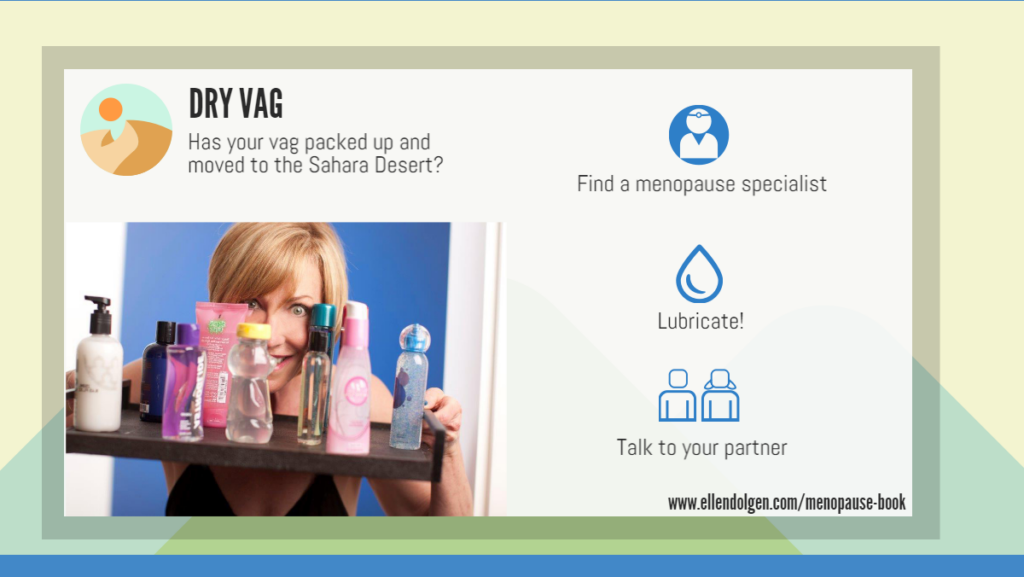Let’s face it, love can hurt. And I’m not talking about the he-left-me-for-a-younger-model-and-broke-my-heart kind of hurt. I’m talking about the physical pain that can be associated with intercourse during menopause.
There’s actually a medical term for painful intercourse: dyspareunia (really??) If you’re experiencing pain during sex, you could be suffering from vaginal atrophy or VA (I used to think VA stood for Virginia, which ironically, is for lovers.). VA is also known as vulvovaginal atrophy or VVA. The latest appellation, courtesy of the North American Menopause Society (NAMS), is genitourinary syndrome of menopause (GSM), a blanket term to describe menopausal symptoms that occur to the vulva, vagina, and lower urinary tract as a result of estrogen deficiency. Who makes up these words? Once again, the vagina gets the short end of the stick! I can’t even pronounce “genitourinary”! Perhaps NAMS should call in the Opi Nail Color Labeling Committee?
Anyway, vaginal atrophy is just that: a thinning of the vaginal wall thanks to a drop in levels of estrogen, whose job it is to maintain the structure and function of the vaginal wall, elasticity of the tissues around the vagina, and production of vaginal fluid.
We seem to hear more about hot flashes, insomnia, and memory loss, but vaginal discomfort is every bit as difficult—and critical—to deal with as other menopausal symptoms. Vaginal symptoms can negatively impact not only on your relationships and sexuality, but your quality of life and self-image.
In my experience, most women don’t even know what VA is, nor understand that it is a chronic problem that requires ongoing treatment and IS treatable.
What are the symptoms of VA?
- Vaginal dryness
- Vaginal burning
- Vaginal discharge
- Genital itching
- Burning with urination
- Urgency with urination
- More urinary tract infections
- Urinary incontinence
- Light bleeding after intercourse
- Discomfort with intercourse
- Decreased vaginal lubrication during sexual activity
- Shortening and tightening of the vaginal canal
Vaginal dryness affects as many as 75 percent of postmenopausal women. Between 17 and 45 percent of postmenopausal women say they find sex painful, according to The North American Menopause Society (NAMS). According to the Women’s Health Concern, only 25 percent of these women seek treatment. What may be even more disconcerting is that, according to the International Menopause Society, 70 percent of women say their healthcare providers rarely or never raise the subject with them.
The Closer survey found that vaginal discomfort caused 58 percent of the women surveyed to avoid intimacy and 64 percent to experience a loss of libido.
The NAMS notes that pain during sex (or simply the fear of pain during sex) can trigger performance anxiety or arousal problems in some women. This also can diminish lubrication or cause involuntary—and painful—tightening of the vaginal muscles, called vaginismus. (Another one of these ridiculous words! Where is Merriam Webster when we need her?) It’s a vicious vaginal cycle.
Here are some solutions:
Pelvic Floor Therapy
According to Harvard Medical School, this is a safe and effective technique. A physical therapist uses massage and gentle pressure to relax and stretch tightened tissues in the pelvic area. You also learn exercises to help strengthen your pelvic floor muscles, which may have been weakened by aging, childbirth or hormonal changes. Now that’s a massage with a happy ending!
Personal Lubricant or Moisturizer
Both can go a long way in the bedroom. However, your vagina may need more. Non-hormonal vaginal lubricants can help decrease friction and discomfort during intercourse. Be sure that they are water-based and designed for vaginal use. Petroleum-based lubricants can harbor bacteria in the vagina and lead to infection, as well damage latex condoms. Vaginal moisturizers, similar to facial moisturizers can help relieve dryness and rebalance the acidity of the vagina, and most women find these helpful to use every day. Both lubricants and moisturizers provide temporary relief of symptoms but often do not treat the underlying condition of vaginal atrophy.
Time for a lube job? Here are the three basic categories of lube:
Water Based lubes can contain a number of plant based ingredients (in addition to water), such as aloe (aloe barbadensis), guar gum (Cyamopsis tetragonolobus), flax seed extract (Linum usitatissimum), and locust bean gum (Ceratonia siliqua). They are often combined with preservatives—some natural, such as tocopherols (vitamin E) and citric acid, and in other cases synthetic preservatives, such as potassium sorbate, parabens and propylene glycol. They can also contain glycerin, xylitol and phenoxyethanol. They tend to dry out much faster than oil or silicone based lubes and can become tacky (heaven knows, we don’t want to wear anything tacky) and sticky. However, they clean up easily, do not stain the bed sheets, and get along just fine with latex condoms and toys. Some newer lubricants contain carrageenan (a seaweed product), which minimizes the tackiness or stickiness associated with water based lubes.
Oil Based lubricants, which cannot be used with latex condoms or latex toys, can be either pure natural oils, a mix of natural and petrochemical oil, or pure petrochemical oil. If condoms are required, either Polyurethane or Polyisprene condoms can be used. As natural oils, some people use Organic 100% Sweet Almond Oil (this contains oleic and linoleic essential fatty acids, which helps your muscles relax) or Organic 100% Virgin Coconut Oil (this can help prevent yeast and bladder infections) as a lubricant. These oils will not burn or inflame the vagina or the penis.
Silicone Based lubricants are, you guessed it, silicone based. Dimethicone (Polydimethysiloxane or PDMS) is the form of silicone used in the better silicone lubricants. It does not dry out as some water based lubricants do, has a thick lush feeling, and is generally considered to be non-toxic and non-irritating (this, of course, can depend on the individual user). It does cause damage to silicone toys, is difficult to wash off, and can stain bed sheets.
Test all the lubricants on your skin first for potential irritation. Try the inside of your elbow or another spot where the skin is delicate.
I conducted an informal survey among my readers to see which lubes/moisturizers are most popular. Here are their top choices:
- Albolene Face Cream (I know, this one is a bit of a curveball, but hey if it’s safe and it works for you, go for it!)
- Coconut Oil
- Astroglide
- Gun Oil—comes water based and silicone based
- Pink Silicone Lubricant
- Replens
- Sylk
- Sliquid
- Surgilube
- Uberlube Luxury Lubricant
- Vaginal Renewal Complex
If you are all lubed up and still have no relief, see your menopause specialist to see about medical interventions that can help. You do not need to suffer. Talk to your specialist about the various hormone treatment options available. There are two types:
Local Estrogen Therapy (LET) is estrogen applied directly to vaginal tissues, so it goes directly to the affected area with minimal absorption of estrogen into the bloodstream. LET is available in creams, a ring (def not jeweled) and a tablet.
Systemic Hormone Therapy allows estrogen to circulate throughout the bloodstream to all parts of the body. It’s available in many forms: a pill, injection, patch, gel and spray. Systemic HT is most often prescribed for multiple whole-body symptoms of menopause, including night sweats, hot flashes, and others. Some women need a combination of treatments.
The 2016 Revised Global Consensus Statement on Menopausal Hormone Therapy (MHT) which was published in Climacteric June 2016 reports that low-dose vaginal estrogen therapy is recommended for symptomatic women whose symptoms are limited to vaginal dryness or associated discomfort with intercourse. The use of systemic hormone therapy (see below) is not generally recommended in breast cancer survivors, although low-dose vaginal estrogen can be considered with consultation with oncology.
In addition, a new drug was approved by the FDA for painful sex — called Intrarosa. It’s active ingredient is DHEA. This is, also, vaginally administered.
Another option is Osphenia which is a SERM Selective Estrogen Receptor Modulator.
Above all, communicate with your partner. Honesty is definitely the best policy. If you’re avoiding sex due to pain, your partner could misinterpret it as your dissatisfaction with the relationship (or the sex). Remember the guy who called into the radio show about the collapse of his marriage over this very issue? Ask your partner to join you at the doctor visit so he or she can be part of the solution. If sex is a vital part of your relationship—it takes two, as they say—then make this part of your journey a partnership, too.





